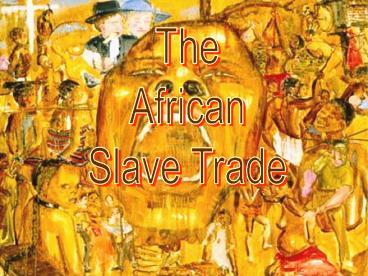The Slave Trade - PowerPoint PPT Presentation
1 / 38
Title:
The Slave Trade
Description:
Title: The Slave Trade Author: Dan and Bren Last modified by: E200702531 Created Date: 12/3/1998 2:38:08 AM Document presentation format: On-screen Show (4:3) – PowerPoint PPT presentation
Number of Views:119
Avg rating:3.0/5.0
Title: The Slave Trade
1
The African Slave Trade
2
Slavery in Africa
3
European - African Pre-Slavery Trade
4
European Background
- Portuguese started African slave trade in 1441
- First Africans in Hispanola in 1505
- 1450-1850 12 million Africans sent to Americas
5
Why Africans?
- No written language , many languages
- Native Americans dying off Some degree of disease
resistance - No muskets and gunpowder
- Africans participated in trade by enslaving
others, selling debtors and criminals, and
kidnapping - Skilled workers
- Knew how to extract precious ore from mines
- Familiar with soils and crops
- Not familiar with the landmaking escape less
likely
6
How to Get Slaves?
- TRADE!
- Africans traded slaves for manufactured goods
like clothe, silk, guns, pots, and copper - African Kingdoms (Asanti) gained wealth and power
from the trade - States sold POW (method of deportation)
- Participated to defend themselves
- African entrepreneurs Middle Men
- Kidnapping
7
Capture
- The original capture of slaves was almost always
violent. - As European demand grew, African chieftains
organized raiding parties to seize individuals
from neighboring societies. - Others launched wars specifically for the purpose
of capturing slaves.
8
(No Transcript)
9
March to the Coast
- What does this picture tell you?
- Europeans did not penetrate the African interior
- Guns
10
Slave Trade in the Congo
11
Cape Coast Castle, W. Africa
12
What role did geography play in the Triangle of
Trade?
13
Correcting Misconceptions
- Africans sold their brothers and sisters into
slavery - There was no one African identity
- Africa is a BIG placemany different ethnic groups
WRONG
14
Portuguese Slave Trade
- The Portuguese population was too small to
provide a large number of colonists. - The sugar plantations required a large labor
force. - Slaves filled this demand.
Europeans and Africans Meet to Trade
15
(No Transcript)
16
Slave Trade and Sugar
- Portuguese crop growers extended the use of slave
labor to South America. - Because of this, Brazil would eventually become
the wealthiest of the sugar-producing lands in
the western hemisphere.
17
European Slave Trade
18
Plantations
- After crossing the Atlantic, most African slaves
went to plantations in the tropical or
subtropical regions of the western hemisphere. - The first was established by the Spanish on
Hispaniola in 1516. - Originally the predominant crop was sugar. In
addition to sugar, plantations produced crops
like tobacco, indigo, and cotton. - In the 1530s Portuguese began organizing
plantations in Brazil, and Brazil became the
worlds leading supplier of sugar.
19
Plantations
- All were designed to export commercial crops for
profit. - Relied almost exclusively on large amounts of
slave labor supervised by small numbers of
European or Euro-American managers.
Brazilian sugar mill in the 1830s
20
As the major European powers of Portugal,
Britain, France, and the Netherlands looked for
ways to exploit the fertile lands of the New
World, they looked to Africa for a steady supply
of labor. Soon, African slaves had become
absolutely vital to the cultivation of sugar,
tobacco, cotton, and rice plantations. As
European demand for sugar began to increase,
plantations began to spring up throughout Brazil
and the Caribbean. Sugar cultivation created a
huge demand for slave labor from Africa. Many
plantations produced additional crops such as
indigo, rice, tobacco, and coffee.
21
Justification
- Slavery made development of the New World
profitable - Native American slaves died of diseases, escaped
easily - African tribes needed weapons and supplies
from Europe
22
Slavery Expands
- In 1518, the first shipment of slaves went
directly from West Africa to the Caribbean where
the slaves worked on sugar plantations. - By the 1520s, the Spanish had introduced slaves
to Mexico, Peru, and Central America where they
worked as farmers and miners. - By the early 17th century, the British had
introduced slaves to North America.
23
Black Gold for Sale!
24
(No Transcript)
25
(No Transcript)
26
Triangular Trade
27
Exportation
- Trip called the Middle Passage
- 5000 miles, 3 wks. to 3 mos.
- 20-25 died
- Strip Africans self respect and self identity
28
The Middle Passage
Unimaginable Suffering
29
Slave Master Brands
30
The Middle Passage
31
The Middle Passage
32
(No Transcript)
33
Correcting Misconceptions
- Africans sold their brothers and sisters into
slavery - There was no one African identity
- Africa is a BIG placemany different ethnic groups
WRONG
34
Notice of a Slave Auction
35
Inspection and Sale
36
First Slave AuctionNew Amsterdam (Dutch New York
City - 17c)
37
IMPACT ON WEST AFRICA
Europeans began the Atlantic slave trade in the
1500s. Their colonies in the Americas needed
labor to work on large plantations. European
traders sold enslaved Africans to colonists.
Families were split up, and many people died. By
the time the slave trade ended in the 1800s,
millions of Africans had been taken from their
homes.
38
Impact of Slave Trade on the Americas
- Cultural Diffusion
- --The slave trade spread ideas
- and goods between cultures (cultural
diffusion). - --Europeans brought new weapons to Africa.
- --Africans brought part of their culture (like
music - food, traditions, Language) to the Americas.































